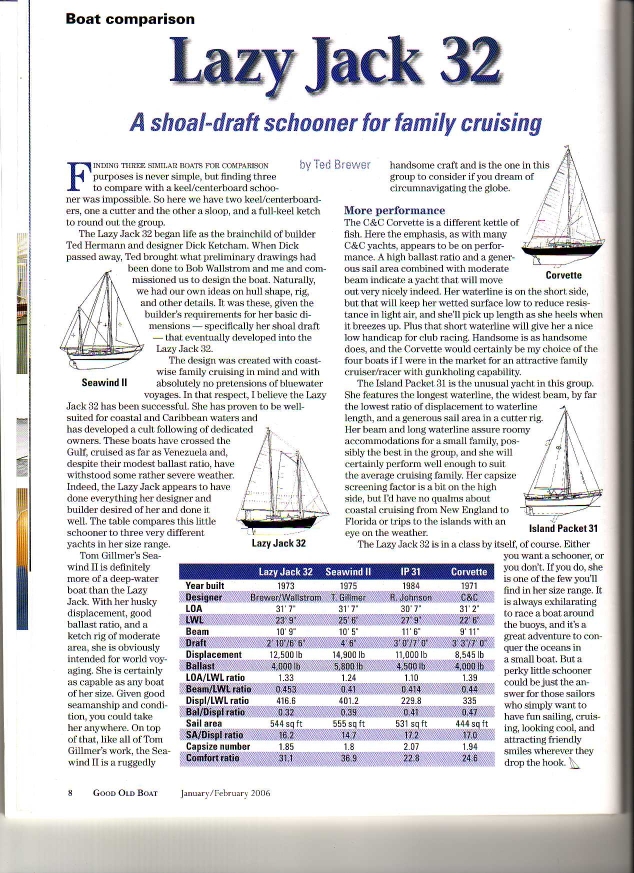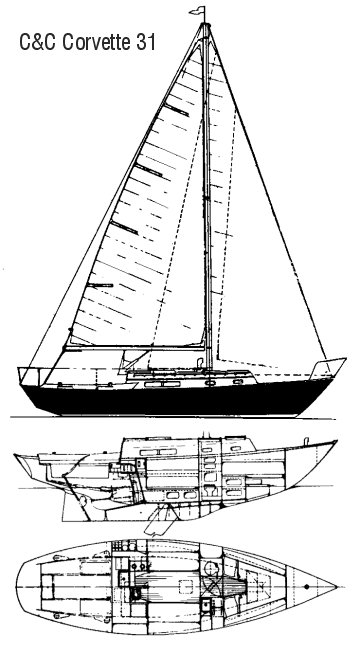The C&C Corvette is a fibreglass-hulled 31-foot sailboat that was produced from 1966 to 1971 by Belleville Marine Yard/Morch Marine in Belleville, Ontario, Canada. It was designed by Cuthbertson & Cassion Ltd. in 1965. C&C is a Canadian company with a long history of designing and building both cruising and racing sailboats. C&C was known for the racer/cruiser and was known for delivering high quality boats at reasonable prices. The Corvette was one of the first very successful boats the company designed. It is a boat than can be used to cruise in coastal waters, while also being suitable to sail across the ocean. It features full, but basic, amenities and can sleep up to five aboard. A total of 167 were built. The Corvette is a very fine looking, comfortable, and seaworthy boat that has a very loyal following.
Specifications | History | SORC Racing | The WWII Corvette | Good Old Boat Article
Specifications
The C&C Corvette is a 31-foot shoaldraft keel boat. It draws 39 inches with the center board up and 7 feet with the board down. Drawings of the boat are shown below:
|
History
A total of 167 Corvettes were built from 1966 to 1971.
Corvette No. 1 was “Victoria”, delivered to John Hilton in spring/early summer 1966.
The peak production years were 1968/69 when 41 were built and 1969/70 when 52 were delivered. Production scheduling called for another 52 to be built in 1970/71 but closure of the Belleville operation in mid 1971 terminated the production of the Corvette and her larger sisters, which were the Frigate (36′) and the Crusader (40′).
The Corvette was designed to the C.C.A. (Cruising Club of America) rule. That rule favoured heavy displacement and shoal draft (and yawl rigs) and the best remembered example of the type would doubtless be “Finisterre”, designed by Sparkman & Stephens and the three-time winner of the Bermuda Race. Although the type had evolved on the race course, they were such thoroughly useful boats that they were adopted by the market in general, although the complication of yawl rig and centreboard assembly, coupled with heavy displacement, certainly did not make for inexpensive boats even though, in hind sight, the original Corvette pricing of $12,500 and subsequently $13,750 seems remarkably reasonable today.
Corvettes were built at the Belleville Marine Yard, owned by Ian Morch. The shoal draft appealed, to Ian not just for his home waters of the Bay of Quinte, but also because of potential markets such as Montreal and the Chesapeake. In both areas the Corvette was well received and quite a few were sold.
Ian chose the name, and definitely had the convoy escort vessels in his mind. In time, the Frigate continued the theme.
In summary, the Corvette design should be viewed as a good example of the type of yacht which evolved under the C.C.A. rule when the family cruiser could also be an effective racer.
S.O.R.C. Racing Performance
(Press Release from Belleville Marine Yards Limited re the 1968 S.O.R.C)
Note: The S.O.R.C. is a series of sailing races for large sailboats.
We can now give you a full run down on our Corvette’s showing in the S.O.R.C. events this year.
In the first race entered, the Lipton Cup Race, held off Miami, “Elektra” finished first in the Class D and 24th overall in a fleet of over 100 yachts. This race was sailed in fluky light winds between 5 and 10 knots. Her elapsed time for the 25 mile course was 7:18:30, which gave her a four minute lead over the next Class D boat to finish, “Nina”. On a boat-for- boat basis, “Elektra” finished ahead of several Class C boats and took the Tartan 34 “Tangent” by 00:10:30, the Morgan 34 “Damn Yankee” by 00:22:29 and the Luders 33 “Pinkletink” by 00:25:21. On corrected time, “Elektra” was better than many Class C yachts, including the Alberg 37 “Dushka IV” and the Bristol 39 “Maraspel”. She was also able to take the noted “Panacea” from Class A. Ian reports this as a good, if frustrating, race with the boat and crew performing well in the first time out.
“Elektra II” sailed the 184 mile Miami-Nassau race and finished 2nd in Class D and 2nd overall. In a variety of light to moderate winds, the Class D boats were favoured and came out with the first five places. Although she was fourth to finish in her class, she saved her time on all but “Nina”, having a corrected time of 31:12:04, taking the Luders 33, the Tartan 34 and the Morgan 34. She also headed the Columbia 40 “Fairweather” by a whopping one hour on elapsed time and two hours on corrected time. The third race, for the Governor’s Cup, off Nassau – a 25 mile windward-leeward effort – became a big boat race all the way with winds of 25 knots. “Elektra” came first in class to beat an Offshore 36 and a Cal 34 boat for boat in this race.
“Elektra II” is a standard Corvette, and is the thirty-fourth built. She is owned by Gordon Stonehouse of Port Credit, Ontario, and had only sailed once prior to this series. She has no special equipment other than what is called for in S.O.R.C. racing and was sailing with Hood sails for this series. Her CCA rating came out at 25.5 which is just a little on the heavy side for a Corvette. Her crew consisted of Ian Morch as skipper, her owner, George Cuthberston, George Hinterhoeller, and Bruce Kirby.
A corvette is a small warship. It is traditionally the smallest class of vessel considered to be a proper (or “rated”) warship. The warship class above the corvette is that of the frigate, while the class below was historically that of the sloop-of-war. The modern types of ship below a corvette are coastal patrol craft and fast attack craft. In modern terms, a corvette is typically between 500 tons and 2,000 tons[1] although recent designs may approach 3,000 tons, which might instead be considered a small frigate.
Primarily designed to be a coastal escort, the Corvettes ended up shouldering the brunt of the escorting of Trans-Atlantic convoys. They were very wet ships to begin with, due to the short fo’c’s’les that ended just short of the bridge, although the later ships were finished with an extended fo’c’s’le and the original ships were mostly refitted as such (shown above). They were also extremely ‘lively’ ships in a heavy sea, and would “roll on wet grass”. As small as they were, they were able to negotiate the waterways leading to the Great Lakes, and many were built there.
When built, they were fitted with magnetic compasses, and did not have an electrical system capable of supporting gyro compasses, which were much more reliable when the ship was being thrown about either due to wave action or the ship’s own depth charges. These were later fitted to most ships. They also had an obsolete sonar with a fixed transducer, which meant that when the ship passed over the submarine to drop depth charges, sonar contact with the sub was lost. This was fixed with the Hedgehog ASW mortar, added to most ships later in the war, which allowed the ship to stand off while firing the mortar bombs and retain sonar contact with the sub. When built, early Canadian corvettes had no radar. They were later fitted with the SW1C radar, which was not all that useful, though better than nothing. The SW1C was later replaced with the SW2C and 2CP, which was only retained for aircraft detection after the British Type 271 was introduced into the RCN.
Few corvettes saw service in Canada after the war, although HMCS SUDBURY was sold and converted into a salvage tug . Others were sold foreign, either into other navies or converted for merchant service as cargo carriers or whaling ships among others.
Article from Good Old Boat (Jan/Feb 2006)
Article from the Jan/Feb 2006 issue of “Good Old Boat” which praises the C&C Corvette.

(re-posted by kind permission of Jack Brewer)
